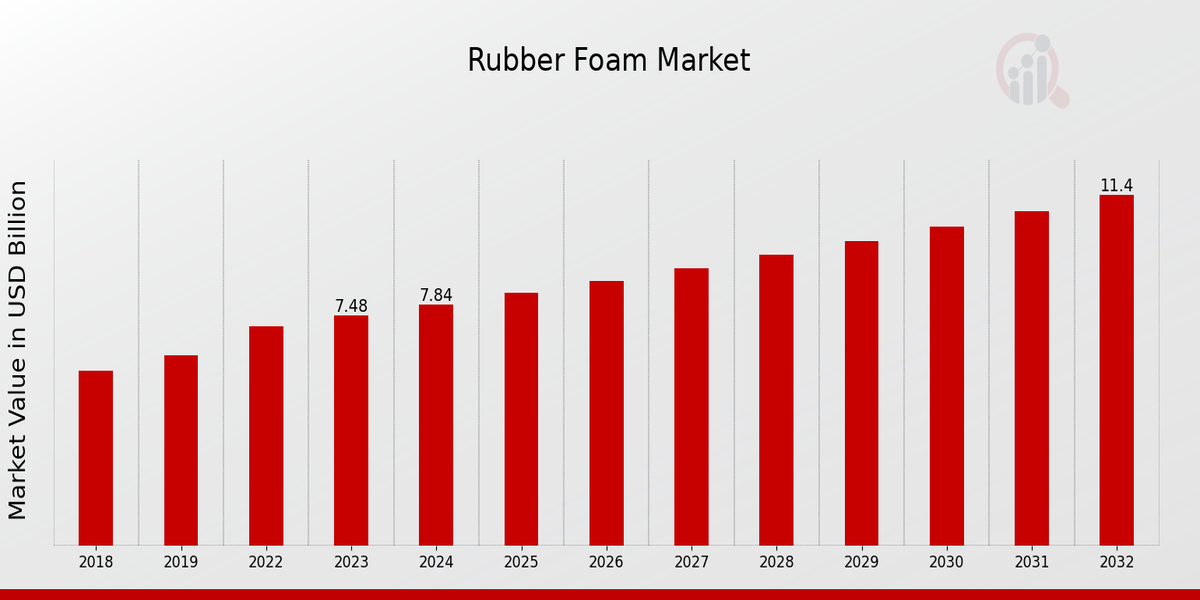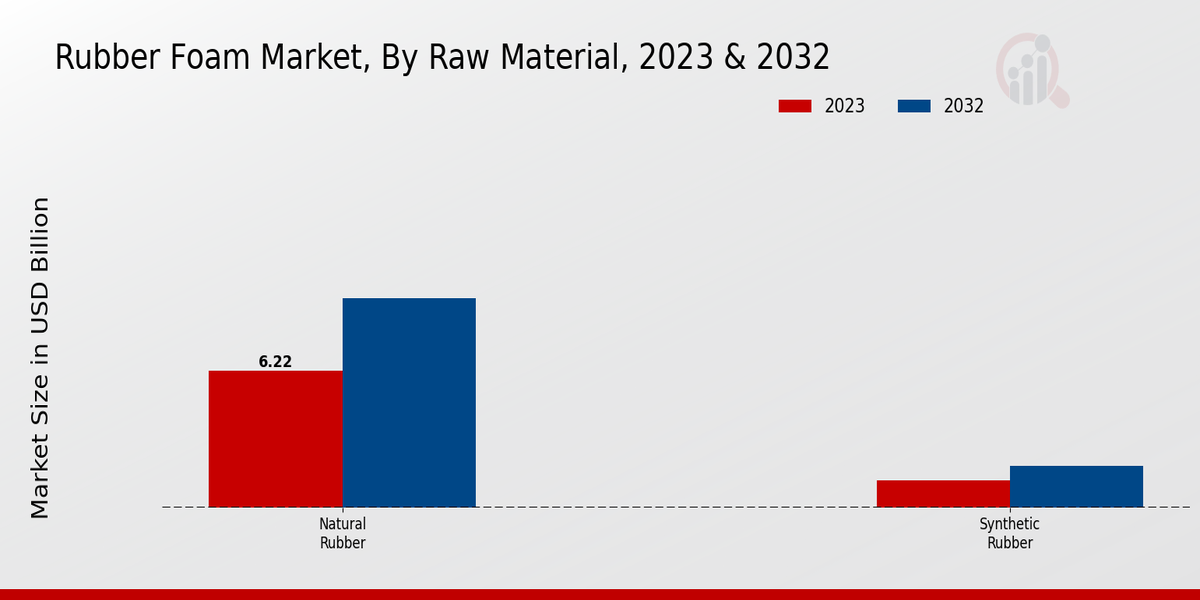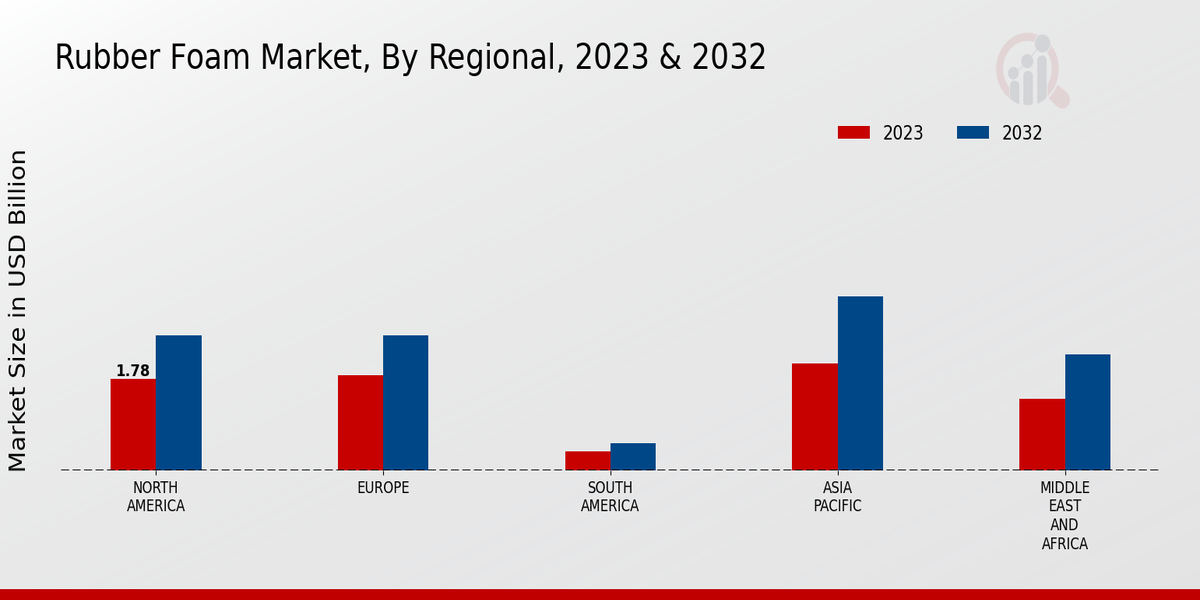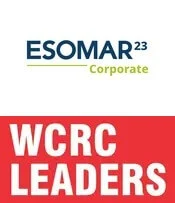Global Rubber Foam Market Overview
The Rubber Foam Market Size was estimated at 8.22 (USD Billion) in 2024.The Rubber Foam Industry is expected to grow from 8.62 (USD Billion) in 2025 to 13.17 (USD Billion) by 2034. The Rubber Foam Market CAGR (growth rate) is expected to be around 4.8% during the forecast period (2025 - 2034).
Key Rubber Foam Market Trends Highlighted
Some of the important market drivers for the Rubber Foam Market are the increasing needs of end-use industries like automotive, construction, and packaging. Continuous growth in urbanization and industrialization, as well as increasing consumer purchasing power, are add-ons to the market strategy. Furthermore, the improvement of production techniques and the launch of new types of foam products are expanding the scope of opportunities.
Untapped opportunities available or which can be seized in the Rubber Foam Market area are the introduction of biodegradable and green foam materials. There is an emerging trend of green alternatives for foam products where there is an emphasis on maintaining environmental conservation. More so, the rising trend towards lightweight and shock-absorbing materials will also offer great chances for the growth of the market.
In recent years, the Rubber Foam Market has been accompanied by growing foam applications in automobiles, especially in lightweight and noise-absorbing systems that help interior materials. Developments in the technology of the foam have resulted in composite foams that have superior thermal insulation properties, hence their demand increase for construction and thermal insulation applications. Custom-designed foam products, as per the requirements of the industries, are also pushing the growth of the market, which has become one of the major trends in the market.

Source: Primary Research, Secondary Research, MRFR Database and Analyst Review
Rubber Foam Market Drivers
Rising Demand for Comfort and Convenience
The increasing need for comfort and convenience in a variety of applications is a key driver of the Rubber Foam Market Industry. Rubber foam provides excellent cushioning and support, which is why it has found numerous applications in the automotive, furniture, bedding, and many other consumer goods companies. The comfort levels desired by consumers are increasing in all aspects of their lives. Thus, there will be a substantial increase in demand for high-quality rubber foam products.In addition, there is an increasing realization of ergonomics and a focus on the safety of the workplace.
Expansion of the Construction Industry
Due to the growing construction industry, especially in developing countries, new opportunities are developing for the Rubber Foam Market Industry. Rubber foam has a wide range of applications in construction, including insulation, roofing systems, and soundproofing, among others. As construction activities are increasing all over the world, the demand for rubber foam products is expected to increase gradually. Furthermore, the demand for rubber foam insulation materials is also expected to grow due to the need for energy-efficient buildings and the need to reduce noise pollution.
Advancements in Technology and Innovation
Advancements in technology and innovation are revolutionizing the Rubber Foam Market Industry. The development of new production techniques and the introduction of high-performance rubber foam materials are enhancing the functionality and durability of these products. Additionally, the growing adoption of automation and digitalization in manufacturing processes is improving efficiency and reducing production costs. These advancements are enabling manufacturers to offer innovative rubber foam solutions that meet the evolving needs of consumers and businesses alike.
Rubber Foam Market Segment Insights
Rubber Foam Market Raw Material Insights
The market growth is attributed to the increasing demand for rubber foam in various end-use industries, including automotive, construction, furniture, and packaging. Raw Material The raw material segment is classified into natural rubber and synthetic rubber. Natural rubber is derived from the sap of rubber trees and is biodegradable and environmentally friendly. Synthetic rubber, on the other hand, is produced from petroleum-based materials and is more resistant to wear and tear. Natural Rubber Natural rubber accounted for a significant share of the raw material segment in 2023 and is expected to continue its dominance throughout the forecast period.The increasing demand for sustainable and eco-friendly materials in various industries is driving the growth of natural rubber. The automotive industry is a major consumer of natural rubber, which is used in tires, hoses, and other components. Synthetic Rubber Synthetic rubber is expected to witness steady growth during the forecast period due to its superior properties, such as durability, resistance to chemicals, and high-temperature resistance. The increasing use of synthetic rubber in the automotive and construction industries is expected to drive its demand.The choice of raw material depends on the specific application and performance requirements. Natural rubber is preferred for applications where biodegradability and environmental sustainability are important, while synthetic rubber is preferred for applications requiring durability and resistance to harsh conditions.

Source: Primary Research, Secondary Research, MRFR Database and Analyst Review
Rubber Foam Market Density Insights
The Rubber Foam Market is segmented by density into low density, medium density, and high density. The low density segment is expected to account for the largest share of the market in 2023, with a market value of 3.2 Billion USD. The medium density segment is expected to account for the second largest share of the market in 2023, with a market value of 2.4 Billion USD. The high density segment is expected to account for the smallest share of the market in 2023, with a market value of 1.9 Billion USD. The market is driven by the increasing demand for rubber foam in various applications, such as automotive, furniture, and construction.The low density segment is expected to grow at the highest CAGR during the forecast period, due to the increasing demand for lightweight and flexible materials in various applications. The medium density segment is expected to grow at a moderate CAGR during the forecast period, due to the increasing demand for comfort and cushioning in various applications. The high density segment is expected to grow at the lowest CAGR during the forecast period, due to the increasing demand for lightweight and flexible materials in various applications.
Rubber Foam Market Application Insights
The Application segment plays a crucial role in shaping the Rubber Foam Market landscape. Among the key applications, Automotive stands out as a significant revenue generator, driven by rising vehicle production and the increasing use of rubber foam in sound insulation, seating, and interior components. The Construction sector is another major application, benefiting from growing urbanization and infrastructure development. Rubber foam finds extensive use in insulation, flooring, and roofing applications, owing to its lightweight, thermal insulation, and sound absorption properties.Packaging is another prominent application, leveraging the protective qualities of rubber foam in safeguarding fragile goods during transportation and storage. Last but not least, Consumer Goods contribute significantly to the Rubber Foam Market, with applications ranging from furniture and bedding to toys and sporting goods. The versatility and comfort provided by rubber foam make it a preferred choice in these segments.
Rubber Foam Market Form Insights
The Rubber Foam Market segmentation by Form includes Blocks, Sheets, and Rolls. Sheets held the largest market share in 2023, and it is projected to continue its dominance throughout the forecast period. This is attributed to the increasing demand for sheets in various end-use industries, such as automotive, construction, and packaging. Blocks are also expected to witness significant growth during the forecast period, owing to their wide usage in insulation and cushioning applications. Rolls are primarily used in the manufacturing of mattresses and other bedding products, and they are expected to experience moderate growth during the forecast period.
Rubber Foam Market End-Use Industry Insights
The end-use industry segment plays a crucial role in shaping the Rubber Foam Market. In 2023, the automotive industry dominated the market, accounting for around 35% of the Rubber Foam Market revenue. The automotive sector's demand for rubber foam arises from its extensive use in vehicle interiors, such as seating, dashboard padding, and sound insulation. The construction industry is another significant end-use segment, projected to grow at a CAGR of 4.5% during 2023-2032. Rubber foam finds applications in construction as insulation, weatherstripping, and roofing materials.Furthermore, the furniture industry utilizes rubber foam for cushioning, padding, and upholstery, contributing to its market share. The medical industry also presents a growing segment, driven by the demand for rubber foam in medical devices, prosthetics, and wound care products. These end-use industry segments collectively drive the Rubber Foam Market's growth, with each sector exhibiting unique requirements and contributing to the market's overall segmentation and dynamics.
Rubber Foam Market Regional Insights
The Rubber Foam Market was valued at USD 7.48 billion in 2023 and is projected to grow at a CAGR of 4.8% from 2024 to 2032. The market is driven by the increasing demand for rubber foam in various end-use industries, such as automotive, construction, and packaging. Regionally, North America is the largest market for rubber foam, followed by Europe and APAC. The North American market is driven by the presence of a large automotive industry, which uses rubber foam for various applications such as seating, insulation, and soundproofing. The European market is also significant, with a growing demand for rubber foam in the construction and packaging industries.The APAC market is expected to grow at the highest CAGR during the forecast period, driven by the increasing demand for rubber foam in the automotive and construction industries. South America and MEA are also expected to contribute to the growth of the Rubber Foam Market. The South American market is expected to grow at a steady pace, driven by the increasing demand for rubber foam in the automotive and construction industries. The MEA market is also expected to grow at a significant rate, driven by the increasing demand for rubber foam in the construction and packaging industries.

Source: Primary Research, Secondary Research, MRFR Database and Analyst Review
Rubber Foam Market Key Players And Competitive Insights
Major players in the Rubber Foam Market industry are adopting various strategies to maintain their position in the competitive landscape. Leading Rubber Foam Market players are focusing on product innovation and expansion in emerging markets to gain a competitive edge. The development of advanced rubber foams with improved properties is a key trend in the Rubber Foam Market. Additionally, collaborations and partnerships between key players are expected to shape the competitive dynamics of the industry.BASF SE, a leading Rubber Foam Market player, offers a wide range of rubber foam products for various applications. The company focuses on research and innovation to develop advanced rubber foam materials with enhanced properties. BASF SE has a global presence and serves customers in diverse industries, including automotive, construction, and packaging. The company's commitment to sustainability and environmental responsibility is also a key factor driving its success in the Rubber Foam Market.Another leading Rubber Foam Market competitor, Recticel NV, offers a comprehensive portfolio of flexible polyurethane foam solutions. The company operates in over 30 countries and has a strong presence in Europe and North America. Recticel NV emphasizes product development and innovation to meet the evolving needs of customers. The company's focus on sustainability and circular economy initiatives positions it well in the competitive market. Recticel NV's strategic acquisitions and collaborations have also contributed to its growth and expansion in the Rubber Foam Market.
Key Companies in the Rubber Foam Market Include
- SibanyeStillwater
- Barrick Gold
- Northam Platinum
- Newmont Corporation
- Lonmin
- Anglo Platinum
- OceanaGold
- Impala Platinum
- Royal Bafokeng Platinum
- Gold Fields
- Moto Goldmines
- Aquarius Platinum
- Alphamin
- Glencore
Rubber Foam Market Industry Developments
Rising demand for rubber foam in various end-use industries, including automotive, construction, and packaging, is driving market growth.Recent market developments include the increasing adoption of eco-friendly rubber foam materials, such as natural rubber and recycled rubber, to meet sustainability goals. Moreover, advancements in production technologies are leading to the development of lightweight and high-performance rubber foam products. Market participants are also focusing on strategic partnerships and acquisitions to expand their product portfolio and geographical reach.
Rubber Foam Market Segmentation Insights
- Rubber Foam Market Raw Material Outlook
- Natural Rubber
- Synthetic Rubber
- Rubber Foam Market Density Outlook
- Low Density
- Medium Density
- High Density
- Rubber Foam Market Application Outlook
- Automotive
- Construction
- Packaging
- Consumer Goods
- Rubber Foam Market Form Outlook
- Rubber Foam Market End-Use Industry Outlook
- Automotive
- Construction
- Furniture
- Medical
| Report Attribute/Metric |
Details |
| Market Size 2024 |
8.22 (USD Billion) |
| Market Size 2025 |
8.62 (USD Billion) |
| Market Size 2034 |
13.17 (USD Billion) |
| Compound Annual Growth Rate (CAGR) |
4.8% (2025 - 2034) |
| Report Coverage |
Revenue Forecast, Competitive Landscape, Growth Factors, and Trends |
| Base Year |
2024 |
| Market Forecast Period |
2025 - 2034 |
| Historical Data |
2020 - 2024 |
| Market Forecast Units |
USD Billion |
| Key Companies Profiled |
SibanyeStillwater, Barrick Gold, Northam Platinum, Newmont Corporation, Lonmin, Anglo Platinum, OceanaGold, Impala Platinum, Royal Bafokeng Platinum, Gold Fields, Moto Goldmines, Aquarius Platinum, Alphamin, Glencore |
| Segments Covered |
Raw Material, Density, Application, Form, End-Use Industry, Regional |
| Key Market Opportunities |
Automotive industry expansion Building and construction sector growth Increasing demand from the packaging industry Growing popularity of memory foam products Rise in disposable income and living standards |
| Key Market Dynamics |
Increased demand from automotive construction and packaging industries, Technological advancements in manufacturing processes, Growing trend towards sustainable and eco-friendly materials, Rising demand from developing economies, Expansion of ecommerce and online sales |
| Countries Covered |
North America, Europe, APAC, South America, MEA |
Frequently Asked Questions (FAQ) :
The Rubber Foam Market size was valued at USD 8.22 billion in 2024 and is projected to reach USD 13.17 billion by 2034, exhibiting a CAGR of 4.8% during the forecast period.
Asia-Pacific is expected to dominate the Rubber Foam Market, accounting for the largest market share throughout the forecast period. The growth in this region can be attributed to the increasing demand for rubber foam in various end-use industries such as automotive, construction, and furniture.
The growth of the Rubber Foam Market is primarily driven by the increasing demand for lightweight and durable materials in various industries. Rubber foam offers excellent cushioning, insulation, and sound absorption properties, making it suitable for a wide range of applications. Additionally, the rising awareness about sustainability and the growing adoption of eco-friendly materials are further contributing to the market growth.
Rubber foam finds applications in a diverse range of industries, including automotive, construction, furniture, packaging, and sports & recreation. In the automotive industry, rubber foam is used for seating, headrests, and sound insulation. In construction, it is employed as insulation material, flooring underlayment, and weatherstripping. In the furniture industry, rubber foam is utilized for cushioning and support in mattresses, sofas, and chairs.
The Rubber Foam Market is highly competitive, with a number of established players operating in the market. Some of the key competitors include Armacell, The Dow Chemical Company, BASF SE, Recticel, and Rogers Corporation.
The Rubber Foam Market faces certain challenges, including fluctuations in raw material prices, intense competition, and environmental regulations. The volatility in the prices of natural rubber, a key raw material for rubber foam production, can impact the overall cost structure and profitability of manufacturers.
One of the key trends in the Rubber Foam Market is the growing demand for sustainable and eco-friendly materials. Manufacturers are increasingly focusing on developing rubber foam products that have a reduced environmental impact, such as those made from recycled or bio-based materials.
The Rubber Foam Market is expected to exhibit a CAGR of 4.8% during the forecast period from 2025 to 2034.
he growing adoption of rubber foam in new applications, such as in the healthcare and aerospace industries, presents emerging opportunities for market growth. Additionally, the expansion of the construction sector in emerging economies is expected to drive demand for rubber foam in insulation and other applications
When considering an investment in the Rubber Foam Market, it is important to assess factors such as the competitive landscape, regulatory environment, technological advancements, and macroeconomic conditions. Additionally, investors should evaluate the financial performance and growth strategies of potential investment targets.















